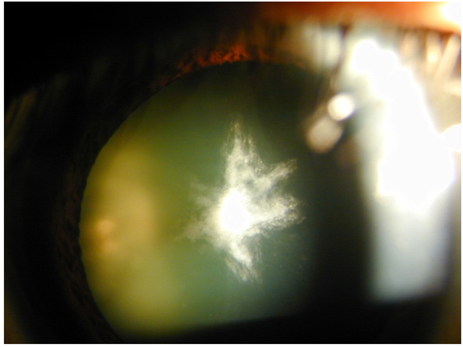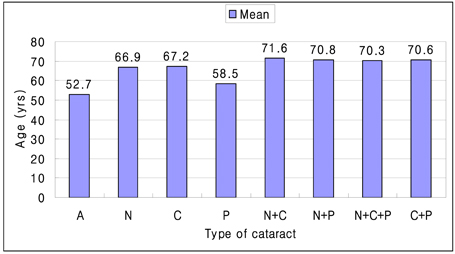Korean J Ophthalmol.
2008 Jun;22(2):77-80. 10.3341/kjo.2008.22.2.77.
The Prevalence and Demographic Characteristics of Anterior Polar Cataract in a Hospital-Based Study in Korea
- Affiliations
-
- 1Department of Visual Optics, Division of Health Science, Baekseok University, Cheonan, Korea.
- 2Department of Ophthalmology and Visual Science, College of Medicine, The Catholic University of Korea, Seoul, Korea. ckjoo@catholic.ac.kr
- KMID: 1098999
- DOI: http://doi.org/10.3341/kjo.2008.22.2.77
Abstract
- PURPOSE: Anterior Polar Cataract (APC) develops by a mechanism different from that of other age-related cataracts, and outside of Korea, it is an extremely rare condition. We investigated the prevalence and epidemiological characteristics of APC in Koreans. METHODS: The evaluation on the prevalence of APC in comparison to the other age-related cataracts was performed on the 2,108 cataract patients who were treated at 5 different areas in Korea from August 2003 to December 2003. The demographic characteristics of APC were studied on the, 656 cataract patients who were treated from January 2004 to January 2005 at one hospital. These patients were classified according to the type of lens opacity (nuclear, cortical, posterior subcapsular, mixed and APC). RESULTS: The prevalence of patients with APC among all the cataract patients was 6.02% during the 5 months in this hospital-based study. Eighty-seven per cent of patients with APC were male. In contrast, the proportion of female was greater than 50% in the other cataracts. The mean age of APC patients was 52.7 years. Among the APC patients, 38.9% were under 50 years of age, 42.6% in their 50s, 14.8% in their 60s, and 3.7% were in their 70s. However, 80% of patients were over the age of 60 years in nuclear, cortical, and mixed-type cataracts. CONCLUSIONS: The prevalence of APC among all cataracts was high in comparision with another country. The proportion of APC was high in individuals younger than 60 years of age, and in males.
MeSH Terms
Figure
Cited by 1 articles
-
Time Series Changes in Cataract Surgery in Korea
Ju Hwan Song, Jung Youb Kang, Ki Yup Nam, Seung Uk Lee, Sang Joon Lee
Korean J Ophthalmol. 2018;32(3):182-189. doi: 10.3341/kjo.2017.0072.
Reference
-
1. Kelly SP, Thornton J, Edwards R, et al. Smoking and cataract: review of casual association. J Cataract Refract Surg. 2005. 31:2395–2404.2. Mukesh BN, Le A, Dimitrov PN, et al. Development of cataract and associated risk factors the visual impairment project. Arch Ophthalmol. 2006. 124:79–85.3. Hennis A, Wu SY, Nemesure B, et al. Risk factors for incident cortical and posterior subcapsular lens opacities in the Barbados Eye Studies. Arch Ophthalmol. 2004. 122:525–530.4. Hiller R, Sperduto RD, Ederer F. Epidemiologic associations with nuclear, cortical and posterior subcapsular cataracts. Am J Epidemiol. 1986. 124:916–925.5. Mohan M, Sperduto RD, Angra SK, et al. India-US Case-control Study of age-related cataracts. Arch Ophthalmol. 1989. 107:670–676.6. Leske MC, Wu SY, Hyman L, et al. Biochemical factors in the lens opacities case-control study. Arch Ophthalmol. 1995. 113:1113–1119.7. Joo CK, Lee EH, Kim JC, et al. Degeneration and transdifferentiation of human lens epithelial cells in nuclear and anterior polar cataracts. J Cataract Refract Surg. 1999. 25:652–658.8. Chylack LT Jr, Wolfe JK, Singer DM, et al. The Lens Opacities Classification System III. Arch Ophthalmol. 1993. 111:831–836.9. West SK. Looking forward to 20/20: a focus on the epidemiology of eye diseases. Epidemiol Rev. 2000. 22:64–70.10. Jaafar MS, Robb RM. Congential anterior polar cataract: a review of 63 cases. Ophthalmology. 1984. 91:249–254.11. Brian G, Taylor HR. Cataract blindness: challenge for the 21st century. Bull World Health Organ. 2001. 79:249–256.12. Kim H, Park JW, Joo CK. An Epidemiological Study of the Risk Factors Associated with Anterior Polar Cataract. J Korean Ophthalmol Soc. 2003. 43:606–614.13. Leske MC, Chylack LT, Wu S. The lens opacities case-control study: risk factors for cataract. Arch Ophthalmol. 1991. 109:244–251.14. Age-related eye disease study research group. Risk factors associated with age-related nuclear and cortical cataract: a case-control study in the age-related eye disease study, AREDS report No. 5. Ophthalmology. 2001. 108:1400–1408.15. Buch H, Vinding T, Nielsen NV. Prevalence and long-term natural course of retinoschisis among elderly individuals: The Copenhagen City Eye Study. Ophthalmology. 2007. 114:751–755.16. Maccarty CA, Mukesh BN, Fu CL, et al. The epidemiology of cataract in Australia. Am J Ophthalmol. 1999. 128:446–465.17. Shin KH, Hong NS, Ahn SK. The prevalence and morphological characteristics of senile cataract in the local areas of Korea. J Korean Ophthalmol Soc. 1992. 33:1154–1161.18. Majima K, Majima U. Histopathological and cell biological analyses of the formation mechanism of anterior polar cataract. Ophthalmologica. 1999. 213:34–39.19. Klein BEK, Klein R, Ritter LL. Is there evidence of an estrogen effect on age-related lens opacities? The Beaver Dam Eye Study. Arch Ophthalmol. 1994. 112:85–91.20. Zhang XH, Sun HM, Ji J, et al. Sex hormones and their receptors in patients with age-related cataract. J Cataract Refract Surg. 2003. 29:71–77.21. Bigsby RM, Cardenas H, Caperell-Grant A, et al. Protective effects of estrogen in a rat model of age-related cataracts. Proc Natl Acad Sci USA. 1999. 96:9328–9332.
- Full Text Links
- Actions
-
Cited
- CITED
-
- Close
- Share
- Similar articles
-
- An Epidemiological Study of the Risk Factors Associated with Anterior Polar Cataract
- Ultrastructure of Transformed Lens Epithelial Cells in Anterior Subcapsular Cataractous Lens
- A Case of Orbital Mixed Tumor
- The Prevalence and Morphological Characteristics of Senile Cataract in the Local Areas of Korea
- Age-related Changes in Anterior, Posterior Corneal Astigmatism in a Korean Population






